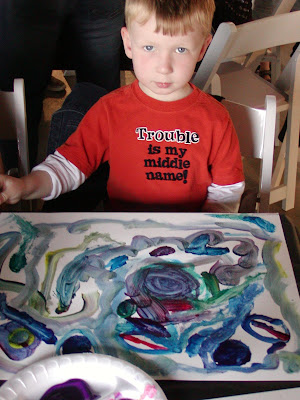




This last Saturday, I was invited to conduct a two hour abstract painting workshop for families and individuals. This was sponsored by a fabulous gallery here in Sacramento called 40 Acres Gallery. They specialize in exhibiting artist from across the nation. In fact, the workshop was on the last day of the Peter Wayne Lewis exhibit. Peter is an internationally known abstract artist. I gave a short lecture on abstract art and off they went. The excitement was the same as when the starting gates open at the Kentucky Derby! The gallery supplied the over 40 participants with watercolor paper, brushes, tempera paints. I brought in tooth brushes (for spattering) and foam rubber daubers. #1 photo sets the scene. #2 photo gives you an idea of the energy. #3 photo is TROUBLE! #4 photo shows a newby artist who decided to sleep instead. #5 photo is a multi tasking participant. What fun they had, what fun I had!












